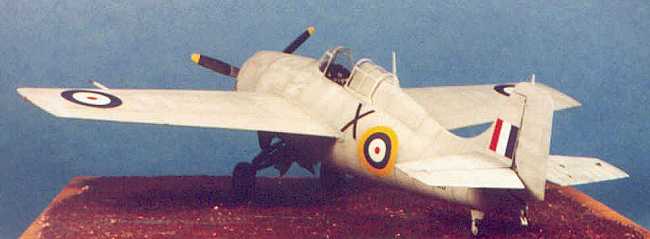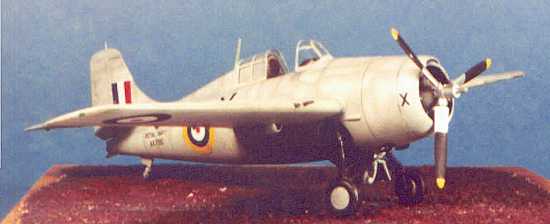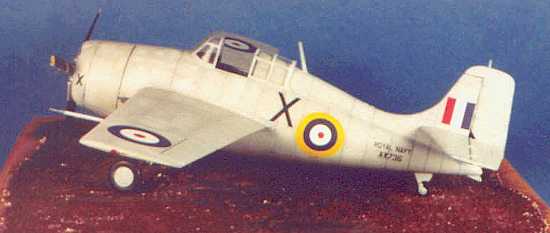
|
KIT: |
Tamiya 1/48 F4F-4 Wildcat |
|
KIT # |
61034 |
|
PRICE: |
$26.00 |
|
DECALS: |
See Review |
|
REVIEW & |
|
|
NOTES: |
KMC F4F-3 conversion
and |
DESERT CAT: CONVERTING THE TAMIYA F4F-4 TO A MARTLET III

|
HISTORY |
In October 1940, Greece was attacked by the Italian Army. Though the Greeks repulsed the first Italian attack, the situation was difficult because Hitler was ready to reinforce his ally. A Greek Purchasing Commission came to the United States in November, where they were able to secure the agreement of the U.S. Navy to release the first 30 F4F-3A Wildcats. These aircraft differed from the standard F4F-3 in that they were powered by an R-1830-90 Twin Wasp with a single-stage, two-speed supercharger, as opposed to the two-stage supercharger in the original model aircraft. The thirty F4F-3As were crated and shipped to Greece in April, 1941.
By the time the aircraft arrived at Gibraltar in early May, 1941, Greece had fallen to Hitler's attack, and the airplanes were homeless. The aircraft were taken on charge by the Fleet Air Arm as Martlet IIIs, and sent on to Egypt.
In Egypt, the Martlet IIIs equipped 805 Squadron beginning in June 1941,
replacing Sea Gladiators. With two other Sea Hurricane units, 805 Squadron and
the Martlets became part of the Royal Navy Fighter Squadron which flew under RAF
control from Dekheila along the Egyptian-Libyan border. On September 28, 1941,
Sub-Lieutenant W.M. Walsh recorded the Martlet's second aerial victory of the
war when he shot down an Italian G.50 in the opening of Operation Crusader, the
British advance into Libya.
On December 28, 1941, Sub-Lieutenant A.R. Griffin - who had been unable to take off with his original patrol flight - was alone over a convoy when four S.M.79 Sparviero torpedo bombers were spotted. Griffin forced two of the bombers to jettison their loads when he intercepted them, and shot a third S.M.79 into the water. Diving to attack the fourth Italian bomber, he was shot down just as the S.M.79 dropped its torpedo, which failed to get a hit. Observers saw the Martlet explode on impact with the water.
The Martlet IIIs were in action in North Africa until August 1942, shooting down a Ju-88 in February and two more S.M.79s in July.
In late August, 805 and its Martlets were transferred to Abyssinia for coastal patrols, and eventually wound up in northern Kenya in 1943, where they were able to maintain a high in-commission rate despite conditions so primitive that the pilots frequently found lions in the back yard of their mess. The aircraft were removed from operations in 1944.
|
THE KIT |
What needs to be said about the Tamiya Wildcat that hasn't already been said? It is accurate, with some of the best-looking surface detail on any kit, well-designed and so easy to assemble that someone building their first plastic kit would be able to create a nice-looking model with this.
When the F4F-4 first came out, I was in great hopes that Tamiya would follow-up this winner with an F4F-3 and an FM-2. Unfortunately, to date that has not been the case, which means the only way a modeler can create an F4F-3 is either by scratch-modification of the basic kit - which involves some effort but is certainly far from impossible - or through use of a resin aftermarket set. Again unfortunately, the only aftermarket set for creating the F4F-3 was released in 1997 by KMC, and is now long out of production since the company went out of existence in 1999. Fortunately, I was able to pick up the conversion set at a recent model show.
|
CONSTRUCTION |
The first thing one has to do is cut off the lower wings from the fuselage lower center section. Past that, the fuselage is assembled per instructions, though you should remember that the full cockpit floor of the kit is inaccurate for any Wildcat other than the FM-2. This problem is easily solved with a razor saw; simply cut away that part of the floor outboard of the foot guides. I used the leftover plastic to create the sides of the gas tank.
Remember that an F4F-3 would have had the cockpit painted in Dull Dark Green or Bronze Green, not interior green. Also, there would be no shoulder harnesses on the seat as the airplane was produced with lap belts only.
The Conversion:
 First things first:
decide which version of F4F-3 you are going to do, and then use the resin
cowling conversion parts to create it. This varies from sub-type to sub-type;
the F4F-3A cowling is synonymous with the original cowling for the first 50
F4F-3s as detailed in the instructions. This involves using resin cowl parts and
the kit cowl ring. I then painted the engine and the interior of the cowling,
assembled the engine and attached it and the cowling to the fuselage.
First things first:
decide which version of F4F-3 you are going to do, and then use the resin
cowling conversion parts to create it. This varies from sub-type to sub-type;
the F4F-3A cowling is synonymous with the original cowling for the first 50
F4F-3s as detailed in the instructions. This involves using resin cowl parts and
the kit cowl ring. I then painted the engine and the interior of the cowling,
assembled the engine and attached it and the cowling to the fuselage.
The wings are the weak part of this whole conversion. The only way to attach them is to butt join them to the fuselage with cyanoacrylate. This is easy, but remember they can snap off without a lot of force being applied.
Once the kit was together, I applied Mr. Surfacer to the fuselage centerline seams and the wingroots. While that was drying, I painted the wheel well light grey and painted and assembled the landing gear, which would not be attached until after the model was painted.
I also used the Squadron vacuform canopy for the Tamiya Wildcat (which is different from the other canopy designed for the old Monogram kit, so be sure to get the right one), since this would allow me to pose the canopy in the open position.
With the seams and joints smooth, the model was ready to go to the paint shop.
|
PAINT & DECALS |
Painting:
 For some reason I
have never been able to understand, it has become "fact" about the Martlet III
that these airplanes were delivered in an overall azure blue paint scheme. This
despite the fact that in the next breath the "experts" point out that the
airplanes were taken right off the Grumman production line, which at the point
the F4F-3A had gone into production had been directed by the U.S. Navy to begin
painting the airplanes overall light grey, as the first step of getting rid of
the prewar peacetime colors and markings. It is also "fact" that the Martlets,
once they got to North Africa, were overpainted with Mid Stone. However, looking
at the only photos available of these airplanes when they were in North Africa
reveals that they are an overall light color, with pre-war style national
markings. Would this not be the U.S. Navy's light grey?
For some reason I
have never been able to understand, it has become "fact" about the Martlet III
that these airplanes were delivered in an overall azure blue paint scheme. This
despite the fact that in the next breath the "experts" point out that the
airplanes were taken right off the Grumman production line, which at the point
the F4F-3A had gone into production had been directed by the U.S. Navy to begin
painting the airplanes overall light grey, as the first step of getting rid of
the prewar peacetime colors and markings. It is also "fact" that the Martlets,
once they got to North Africa, were overpainted with Mid Stone. However, looking
at the only photos available of these airplanes when they were in North Africa
reveals that they are an overall light color, with pre-war style national
markings. Would this not be the U.S. Navy's light grey?
Fortunately, Eagle Strike agreed with my research and called for the Martlet III to be painted overall light grey, for which I used Gunze-Sanyo "Light Gull Grey." The was applied over "pre-shading" of flat black on all panel lines. Once it was finished, I added some flat white to the paint and applied this to the upper surfaces and fuselage sides to simulate sun-fading. This also gave me a multi-hue airplane despite its being all one color, which gets rid of the visual boredom factor.
I painted the propeller as a pre-war Navy aircraft, with the flat black areas outboard of the area directly in front of the cowling opening. The fact that this is seen in a photograph of the Martlet IIIs in North Africa is good evidence that the airplanes had a standard USN scheme, and that they were likely not repainted further by the British. There was too much going on between June 1941 and August 1942 to do something as mundane as take airplanes out of operations to paint them "right." (We must remember, the war was not run by modelers.)
Decals:
 The Eagle Strike
decals go on perfectly. The only place I had any problem was getting the
national insignia to snug down into the curves and differing planes of the
fuselage sides, and this was taken care of with a final coat of Solvaset, which
melted everything in just fine.
The Eagle Strike
decals go on perfectly. The only place I had any problem was getting the
national insignia to snug down into the curves and differing planes of the
fuselage sides, and this was taken care of with a final coat of Solvaset, which
melted everything in just fine.
Final Assembly and Weathering:
After giving the model a final coat of Future followed by two coats of Testors Dullcote to get a very flat sunfaded finish, I assembled the landing gear into the wheel well, attached the exhaust pipes, the small underwing windows, the prop and the canopy. I created gunfire stains and exhaust stains with Tamiya "Smoke," then made the antenna wires with "invisible thread," which looks very much like wire when attached in position.
|
CONCLUSIONS |
The result is a different-looking Wildcat. I would not use the KMC conversion set again, due to the fact that the surface detail is very soft and a number of items - like the flap hinges - were not done very well in the casting and had to be replaced. I found it much easier when I did the FM-1 and FM-2 conversions to modify the kit wing and rescribe the surface detail and this is what I will do when I do another F4F-3 - assuming Tamiya doesn't stop making models with spinning propellers and see how easy it would be to make more money by changing the wing molds to do all the Wildcats.
This was a fun conversion and I am happy with the result.
Review kit and aftermarket items compliments of my billfold.
If you would like your product reviewed fairly and quickly by a site that averages thousands of visits a day, please contact me or see other details in the Note to Contributors.